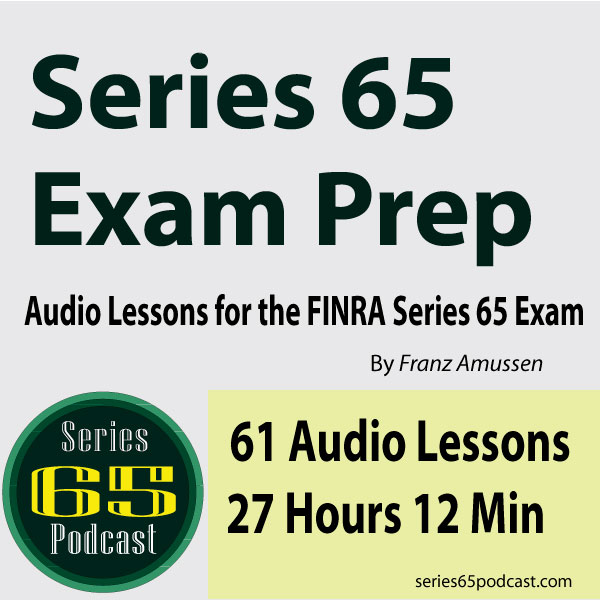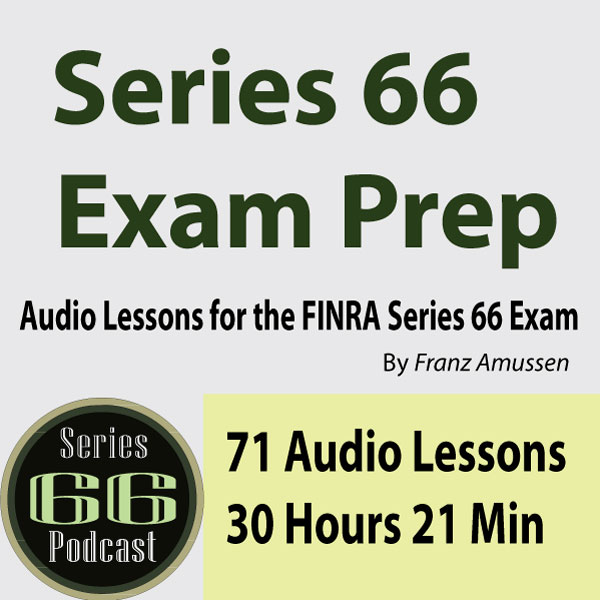The Series 65 vs. Series 66 Exam

Series 65 vs Series 66 exam? The FINRA Series 65 and Series 66 exams are both licensing exams administered by the Financial Industry Regulatory Authority (FINRA) for individuals seeking to work as investment professionals in the United States. While they share similarities, there are distinct differences between the two exams.
- Purpose and Scope:
The Series 65 exam, also known as the Uniform Investment Adviser Law Examination, is specifically designed for individuals who want to become registered investment adviser representatives (IARs). Passing the Series 65 exam is a requirement to register as an IAR in many states, enabling individuals to provide investment advice and manage client portfolios.
The Series 66 exam, also known as the Uniform Combined State Law Examination, is a combination of the Series 63 and Series 65 exams. Its purpose is to qualify individuals as both securities agents and investment adviser representatives. By passing the Series 66 exam, candidates can work as both broker-dealer agents and investment adviser representatives, allowing them to engage in a broader range of financial services.
- Content and Coverage:
The Series 65 exam focuses primarily on investment advisory services. It tests candidates’ knowledge of various topics, including investment strategies, portfolio management, ethical practices, retirement planning, taxation, and regulations pertaining to investment advisers. The exam aims to evaluate candidates’ ability to provide sound investment advice and act in the best interest of clients.
The Series 66 exam covers a broader range of topics compared to the Series 65. It combines the content of the Series 63 and Series 65 exams. The Series 63 portion covers state securities regulations, while the Series 65 portion covers investment advisory concepts. The exam tests candidates’ knowledge of federal and state securities laws, investment vehicles, ethics, and professional conduct. It assesses their ability to comply with both federal and state regulations when providing investment advice and executing securities transactions.
- Exam Structure:
The Series 65 exam consists of 130 multiple-choice questions, and candidates must achieve a score of 72% or higher to pass. The exam duration is 180 minutes (3 hours).
The Series 66 exam consists of 100 multiple-choice questions. Candidates must achieve a score of 73% or higher to pass. The exam duration is 150 minutes (2 hours and 30 minutes).
- Prerequisites:
To sit for the Series 65 exam, candidates are generally not required to have any prior industry-specific licenses or registrations. However, some states may have additional requirements or prerequisites, such as completing certain education courses.
To be eligible for the Series 66 exam, candidates must have already passed the Series 7 exam, which is a general securities representative exam. The Series 7 exam allows individuals to work as general securities representatives and is a prerequisite for the Series 66 exam.
In summary, the Series 65 exam is focused on investment advisory services and qualifies individuals as registered investment adviser representatives. The Series 66 exam combines securities agent and investment adviser representative qualifications, encompassing a broader range of topics. Understanding these key differences can help individuals choose the appropriate exam based on their career goals and the scope of services they intend to provide in the financial industry.
For those who need to study for the Series 63 Exam we have audio lessons
Series 65 Exam Prep: Audio Lessons for the FINRA Series 65 Exam
Table of Contents
Lesson 1 Macro Economic Analysis pt 1 34 36
Lesson 2 Macro Economic Analysis pt 2 32 18
Lesson 3 Yield Curve Balance of Payments and Currency Risk 31 37
Lesson 4 Financial Statements Balance Sheet pt 1 29 46
Lesson 5 Financial Statements Balance Sheet pt 2 25 33
Lesson 6 Financial Statements Balance Sheet pt 3 36 52
Lesson 7 Financial Statements Income Statement pt 1 33 57
Lesson 8 Financial Statements Income Statement pt 2 32 55
Lesson 9 Financial Statements Income Statement pt 3 28 42
Lesson 10 Financial Statements Cash Flow Statement pt 1 17 7
Lesson 11 Financial Statements Cash Flow Statement pt 2 23 39
Lesson 12 Discounted Cash Flow Model 13 9
Lesson 13 Ratio Analysis 14 48
Lesson 14 Technical Analysis 18 53
Lesson 15 Common Stock 38 5
Lesson 16 Preferred Stock 26 5
Lesson 17 Special Securities 17 36
Lesson 18 Fixed Income pt 1 25 22
Lesson 19 Fixed Income pt 2 41 16
Lesson 20 Fixed Income pt 3 40 35
Lesson 21 Money Market 20 2
Lesson 22 CDS ARS SP 27 25
Lesson 23 Municipal Debt 37 2
Lesson 24 Mutual Funds pt 1 28 59
Lesson 25 Mutual Funds pt 2 22 18
Lesson 26 Mutual Funds pt 3 31 37
Lesson 27 ETF ETN and Corp Actions 21 34
Lesson 28 Unit Investment Trusts 31 17
Lesson 29 Annuities 29 37
Lesson 30 Life Ins Viatical Settlements 21 39
Lesson 31 Partnerships 31 54
Lesson 32 REIT’s 31 37
Lesson 33 Present Value, Net PV, IRR, Commodities, Precious Metals 25 46
Lesson 34 Options pt. 1 22 11
Lesson 35 Options pt. 2 21 29
Lesson 36 Options pt. 3 18 22
Lesson 37 Options pt. 4 20 33
Lesson 38 Options pt. 5 30 10
Lesson 39 Options pt. 6 22 21
Lesson 40 Accounts and Anti Money Laundering 29 33
Lesson 41 Accounts and Anti Money Laundering pt 2 14 32
Lesson 42 Account Registration and Anti Money Laundry Rules 16 38
Lesson 43 Client Types and Appropriate Investments 37 52
Lesson 44 Know Your Customer and Portfolio Strategies 30 1
Lesson 45 Investment Taxation 35 55
Lesson 46 IRA Accounts 31 39
Lesson 47 Keogh Plans and Defined Contribution Plans 26 4
Lesson 48 Defined Pension Plans and Contribution Plans 22 10
Lesson 49 Inherited IRA’s, Non Qualified Plans, ERISA, Investment Policy Statement 20 28
Lesson 50 UGTMA, Trusts and Wills, Qualified Domestic Relations order (QDROs) 22 39
Lesson 51 Trading Markets Pt 1 Markets and Order Tickets 25 40
Lesson 52 Trading Markets pt 2 Order Types, Specalists and Dealers 27 23
Lesson 53 Trading Markets pt 3 Rules 34 12
Lesson 54 Trading Markets pt 4 Options 12 35
Lesson 55 Securities act of 1933 and 144 stock 34 2
Lesson 56 Securities and Exchange Act of 1934 and Insider Trading 38 19
Lesson 57 Investment Company Act of 1940 11 22
Lesson 58 Sarbanes Oxley and Blue Sky Laws 22 28
Lesson 59 Investment Advisors Act of 1940 Pt 1 27 25
Lesson 60 Investment Advisors Act of 1940 Pt 2 24 43
Lesson 61 Investment Advisors Act of 1940 Pt 3 28 30
Series 66 Exam Prep: Audio Lessons for the FINRA Series 66 Exam
Table of Contents
Lesson 1 Macro Economic Analysis pt 1 34 36
Lesson 2 Macro Economic Analysis pt 2 32 18
Lesson 3 Yield Curve Balance of Payments and Currency Risk 31 37
Lesson 4 Financial Statements Balance Sheet pt 1 29 46
Lesson 5 Financial Statements Balance Sheet pt 2 25 33
Lesson 6 Financial Statements Balance Sheet pt 3 36 52
Lesson 7 Financial Statements Income Statement pt 1 33 57
Lesson 8 Financial Statements Income Statement pt 2 32 55
Lesson 9 Financial Statements Income Statement pt 3 28 42
Lesson 10 Financial Statements Cash Flow Statement pt 1 17 7
Lesson 11 Financial Statements Cash Flow Statement pt 2 23 39
Lesson 12 Discounted Cash Flow Model 13 9
Lesson 13 Ratio Analysis 14 48
Lesson 14 Technical Analysis 18 53
Lesson 15 Common Stock 38 5
Lesson 16 Preferred Stock 26 5
Lesson 17 Special Securities 17 36
Lesson 18 Fixed Income pt 1 25 22
Lesson 19 Fixed Income pt 2 41 16
Lesson 20 Fixed Income pt 3 40 35
Lesson 21 Money Market 20 2
Lesson 22 CDS ARS SP 27 25
Lesson 23 Municipal Debt 37 2
Lesson 24 Mutual Funds pt 1 28 59
Lesson 25 Mutual Funds pt 2 22 18
Lesson 26 Mutual Funds pt 3 31 37
Lesson 27 ETF ETN and Corp Actions 21 34
Lesson 28 Unit Investment Trusts 31 17
Lesson 29 Annuities 29 37
Lesson 30 Life Ins Viatical Settlements 21 39
Lesson 31 Partnerships 31 54
Lesson 32 REIT’s 31 37
Lesson 33 Present Value, Net PV, IRR, Commodities, Precious Metals 25 46
Lesson 34 Options pt. 1 22 11
Lesson 35 Options pt. 2 21 29
Lesson 36 Options pt. 3 18 22
Lesson 37 Options pt. 4 20 33
Lesson 38 Options pt. 5 30 10
Lesson 39 Options pt. 6 22 21
Lesson 40 Accounts and Anti Money Laundering 29 33
Lesson 41 Accounts and Anti Money Laundering pt 2 14 32
Lesson 42 Account Registration and Anti Money Laundry Rules 16 38
Lesson 43 Client Types and Appropriate Investments 37 52
Lesson 44 Know Your Customer and Portfolio Strategies 30 1
Lesson 45 Investment Taxation 35 55
Lesson 46 IRA Accounts 31 39
Lesson 47 Keogh Plans and Defined Contribution Plans 26 4
Lesson 48 Defined Pension Plans and Contribution Plans 22 10
Lesson 49 Inherited IRA’s, Non Qualified Plans, ERISA, Investment Policy Statement 20 28
Lesson 50 UGTMA, Trusts and Wills, Qualified Domestic Relations order (QDROs) 22 39
Lesson 51 Trading Markets Pt 1 Markets and Order Tickets 25 40
Lesson 52 Trading Markets pt 2 Order Types, Specalists and Dealers 27 23
Lesson 53 Trading Markets pt 3 Rules 34 12
Lesson 54 Trading Markets pt 4 Options 12 35
Lesson 55 Securities act of 1933 and 144 stock 34 2
Lesson 56 Securities and Exchange Act of 1934 and Insider Trading 38 19
Lesson 57 Investment Company Act of 1940 11 22
Lesson 58 Sarbanes Oxley and Blue Sky Laws 22 28
Lesson 59 Investment Advisors Act of 1940 Pt 1 27 25
Lesson 60 Investment Advisors Act of 1940 Pt 2 24 43
Lesson 61 Investment Advisors Act of 1940 Pt 3 28 30
Series 66 Lesson 62 Series 63 Introduction 2 27
Series 66 Lesson 63 Customer Accounts 1 27 31
Series 66 Lesson 64 Customer Accounts 2 21 27
Series 66 Lesson 65 Customer Accounts 3 29 7
Series 66 Lesson 66 Business Practices 20 7
Series 66 Lesson 67 Reg Lic pt 1 18 19
Series 66 Lesson 68 Reg Lic pt 2 23 39
Series 66 Lesson 69 Reg Lic pt 3 22 1
Series 66 Lesson 70 Securities Registration 33 14
Series 66 Lesson 71 Administrative Procedures 21 56
Series 66 Lesson 72 SECURE Act and Accredited investors 18 20



